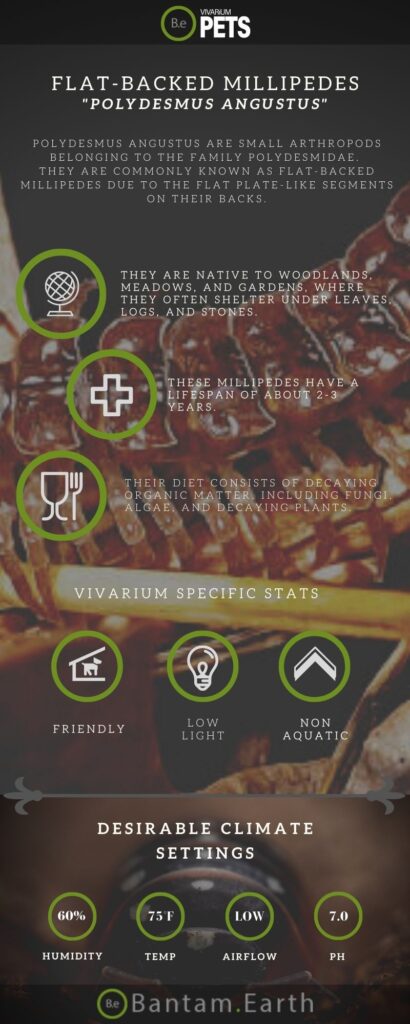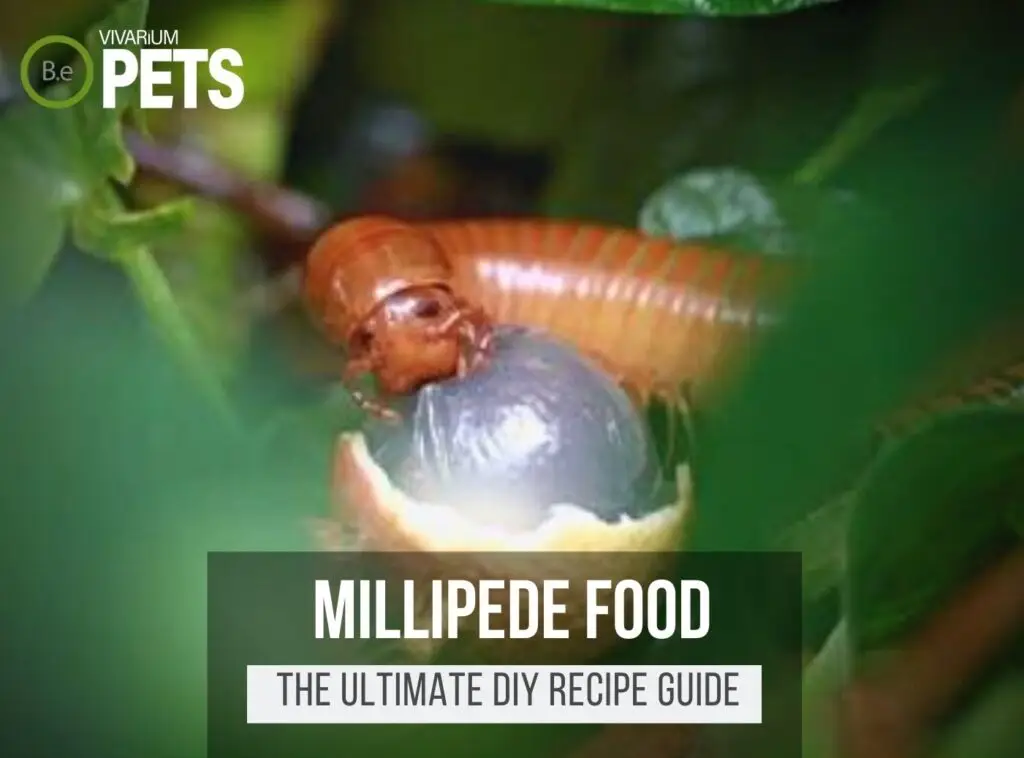It doesn’t get any more creepy-crawly than the fascinating Flat-backed Millipede (Polydesmus angustus)!
These small and attractive invertebrates are incredibly low maintenance and incredibly interesting to observe.
In this comprehensive Polydesmus angustus care guide, we will cover everything you need to know to give your new tiny pet millipedes the best possible care.
Including selecting and setting up a habitat, feeding your millipede, handling and interacting, and recognizing potential health issues.
Let’s dive in and see everything you need to know about Flat-backed Millipede care!
| Characteristics: | |
|---|---|
| Common Name | Flat-backed Millipede |
| Family Name | Polydesmidae |
| Scientific Name | Polydesmus angustus |
| Use | Cleaning, Aerating Soil, Pets |
| Temperament | Non-aggressive |
| Lifespan | 2-3 Years |
| Diet | Detritivore |
| Adult Size | 5.08 cm |
| Breeding Type | Egg Layer |
| Care Level | Easy |
| Minimum Tank Size | 5-10 Gallons |
| pH | 6.5-7.5 |
| Hardness | Moderate |
| Temperature | 65-80°F |
What Are Flat-backed Millipedes?
Polydesmus angustus are small arthropods belonging to the family Polydesmidae.
They are commonly known as Flat-backed millipedes due to the flat plate-like segments on their backs.
These millipedes are found throughout the Northern Hemisphere, most commonly in Europe, Asia, and North America.
They grow to between 4 and 5 cm in length and are nocturnal, meaning they live and feed in the dark.
What Do Flat-backed Millipedes Look Like?
Flat-backed Millipedes are small to medium-sized invertebrates with an appearance that’s both beautiful and unique.
Their bodies are usually black, brown, or reddish-brown and have a glossy and elongated shape with flat dorsal ridges on their backs, hence their name.
Each segment of their bodies has two pairs of legs, and their legs also have an attractive banded pattern that may have stripes of yellow, white, and black.
They can grow to be up to 5+ centimeters long, with the males typically being larger than the females.
Polydesmus angustus also have two sets of antennae and two large eyes that are placed on the underside of the first segment of their bodies.
Benefits Of Using Flat-backed Millipedes
Flat-backed Millipedes offer many benefits to vivariums. For starters, they are great natural cleaners, as they feed on decaying matter and will help keep your enclosure clean.
They are also excellent at aerating the substrate, which is important for maintaining healthy plants and other live decorations.
Finally, Polydesmus angustus are fascinating to observe, with their unique behavior and movements. All of these benefits make Flat-backed Millipedes an excellent option for vivariums!


Flat-backed Millipede Facts
Flat-backed Millipedes are relatively small and are mostly active at night.
They have a lifespan of about 2-3 years and feed on decaying vegetation and other scavenged food.
These little creatures are incredibly docile and make great pets, as they require minimal upkeep and are not known to be destructive or aggressive.
Breeding can also be accomplished in captivity but is rare and challenging.
Habitat
Flat-backed Millipedes are found in a variety of habitats around the world.
They are native to woodlands, meadows, and gardens, where they often shelter under leaves, logs, and stones.
In their natural habitat, they are usually seen in areas with a high amount of moisture, as they love to keep moist whenever possible.
Diet
In their natural environment, they are primarily opportunistic scavengers.
Typically found feeding on decaying organic matter, such as leaves and plant material, as well as the occasional fungus.
Additionally, they will often enjoy small insects, such as flies, snails, and worms.
Temperament
Flat-backed Millipedes are shy creatures who prefer to avoid humans and other animals when possible.
In the wild, they will quickly scuttle away when disturbed.
With proper care and handling, however, they can become more tolerant of their environment and owners.
The best approach to handling and interacting with your Polydesmus angustus is to start slow and allow your new pet to become accustomed to your presence.
When interacting with other animals, Flat-backed Millipedes can become frightened and could become vulnerable to predators.
Therefore, it’s important to take the proper precautions when introducing your pet to other animals.
Lifespan
Polydesmus angustus have a relatively short lifespan compared to other invertebrates; they typically live for about 2-3 years in captivity.
In nature, they are typically preyed upon by larger invertebrates or small mammals, and their lifespan is likely shorter.
Their brief life cycle begins in the early spring when they mate.
During a mating event, males and females will engage in a courtship dance before they mate.
The female will then lay her eggs in soil or leaf litter, typically in a shallow burrow.
Once the eggs hatch, the young millipedes will molt once or twice before they reach maturity the following spring.
Breeding
Polydesmus angustus reproduce by mating with the opposite sex when they reach adulthood.
The male secretes a spermatophore, which is a packet of sperm, and inserts it into the female’s genital opening for fertilization.
After mating, the female spends a few weeks developing the eggs inside her body and eventually lays the eggs in a safe place.
The eggs, which are usually white and shaped like a pill, take a week or two to hatch.
The newly hatched babies are very similar in appearance to adults, though they are much smaller and they lack the characteristic patterning of adults.
It’s important to create the right environmental conditions to ensure successful breeding.
The optimal breeding environment should be kept warm and humid with plenty of substrates for the eggs to be laid in.
Where To Find Flat-backed Millipedes
Flat-backed Millipedes can often be found in the wild in deciduous forests, meadows, and gardens.
They are native to Southern Europe and the Mediterranean regions, so it is easiest to find them in these areas.
They prefer darker, moist environments, so be sure to look in shaded, damp areas beneath logs, stones, and other objects.
If you are looking to purchase Polydesmus angustus, several reptile and pet stores offer them for sale.
When purchasing these millipedes, it is best to purchase one that is already mature.
Additionally, it is wise to purchase two or more millipedes to ensure they have appropriate company.
Flat-backed Millipede Care
Caring for Flat-backed Millipedes requires providing suitable habitat, providing the right substrate and temperature, offering the right diet, and gently interacting with them.
Additionally, it is important to keep an eye out for any potential health issues.
With the right care, these fascinating and low-maintenance invertebrates can make an interesting and rewarding pet for many years.
Tank Requirements
When selecting and setting up an ideal habitat for your Polydesmus angustus, there are a few key factors to consider.
The best type of vivarium is a humid terrarium with a screen lid for adequate ventilation.
The optimal temperature for healthy Flat-backed Millipedes ranges from 70-80 Degrees Fahrenheit, with the humidity level kept between 80-90%.
Along with the environment, it is important to select the right terrarium substrate.
The best substrate is a mix of peat moss soil, leaf litter, and coconut fiber bedding.
You will also want to maintain the substrate pH between 6.0 – 7.0 and the general hardness between 1-8GH.
Lastly, terrarium lighting is important, but it should be indirect. This way, your millipedes can rest in the dark areas, undisturbed.
What Do Flat-backed Millipedes Eat?
Feeding your Polydesmus angustus is an important part of keeping them healthy in captivity.
The best diet for them consists of a variety of fresh, organic fruits and vegetables, such as apples, lettuce, carrots, and broccoli.
In addition, you can also provide them with commercially available mealworms and roaches.
It is vital to provide variety in their diet and to feed them in moderation.
Also remember that Flat-backed Millipedes need a constant supply of food, as they can eat continuously.
It is best to feed them once or twice a day, depending on their size and appetite. Make sure to always remove any uneaten food after a few hours, as it may spoil quickly.
Additionally, dust their food with calcium and vitamin D3 supplements a few times per week to ensure their optimal health.
If you’re more of an avid hobbyist like myself, be sure to check out my ultimate DIY Millipede food guide. I give a more in-depth explanation of the best foods and my favorite recipe.
Best Tankmates For Flat-backed Millipedes
Flat-backed Millipedes make the perfect addition to an invertebrate-only tank with similar beneficial animals.
These peaceful, invertebrates are best kept with other small invertebrates similar in size, such as springtails and isopods.
All three of these species can make great tankmates as they take up only a small amount of habitat space, can coexist peacefully, and require the same type of habitat.
These species of invertebrates also share some similar beneficial attributes.
For example, all three are scavengers, which means that they can help to keep the tank clean by searching for food and collecting organic matter.
They also have a long lifespan and low reproduction frequency, making them an excellent choice for a long-term pet.
So, if you are looking for tankmates for your flat-backed millipedes, consider adding some springtails and pet isopods to the tank.
Conclusion
Congratulations on finishing your journey to becoming a Flat-backed Millipede expert! We hope that by reading this guide, you are now well-equipped to provide your new pet millipede with the best possible care.
With the proper environment, diet, and handling, your new Polydesmus angustus will become an incredible part of your family!
Frequently Asked Questions
Flat-backed Millipedes are found worldwide, primarily in terrestrial environments such as forests, fields, and deserts. They prefer damp environments and are important decomposers, feeding on decaying plant material.
Flat-backed Millipedes are detritivores, which means they feed on decaying plant material such as fallen leaves and rotting wood. These millipedes may also consume small soil organisms, fungi, and algae as part of their diet.

